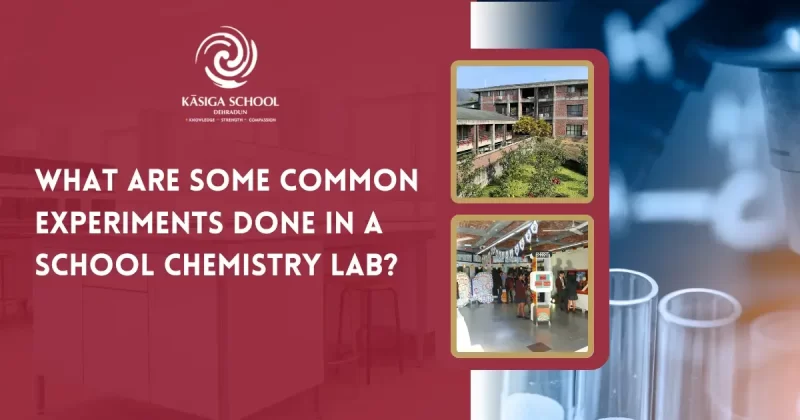Chemistry is perhaps one of the most interactive & fascinating subjects that students in school study. It is not just about studying formulas through books or scribbling equations on paper. The actual fun starts when students enter the chemistry lab & witness science occurring before their very eyes.
For most students, the chemistry lab in school is where they first experience mixing liquids, witnessing colourful reactions, witnessing changes & learning how substances react. It’s a space where they transition from theory to practical knowledge.
Conducting experiments in the lab not only makes learning exciting but also helps students grasp the concepts more effectively. And then, when they actually do observe the chemical reaction, or sense the temperature shift in a reaction, or see gas bubbles in a test tube, those are experiences that remain with them forever.
These little experiences also provide learning grounds for students who may consider taking up science in higher classes or as a profession. So, let’s look at some of the most common chemistry lab experiments for students that are usually done in most schools.
• Litmus Test for Acids & Bases
This is usually one of the first experiments conducted by students in a school chemistry laboratory. In this experiment, students have red & blue litmus paper to use in determining if a substance is acidic or basic. The general idea is that acids make blue litmus paper red & bases make red litmus paper blue. It is a simple yet impressive experiment that introduces the idea of pH in an easy-to-understand manner.
What’s so fascinating about this experiment is how visual it is. Students get to dip paper in different solutions such as lemon juice, vinegar, baking soda, or soap water & instantly notice a color change. Through this, they start understanding the contrast between acidic & basic compounds present even in our daily lives. It’s one of the simplest & basic chemistry experiments in school that builds curiosity in students.
• Reaction Between Iron & Copper Sulphate Solution
It is an old experiment to demonstrate displacement reactions. In this experiment, students place a clean iron nail into a blue-coloured copper sulphate solution & leave it for some time. Gradually, they observe that the solution begins losing its blue colour & a brown coating develops on the iron nail. That brown coating is copper.
This experiment teaches students how more reactive elements will displace less reactive ones from a solution. It also introduces the topic of reactivity series, which becomes crucial in higher classes. This is an extremely helpful experiment for visual learners, as they can see plainly the changes occurring & hence, this is one of the most common chemistry lab experiments for students in middle school & early high school.
• Preparation of Oxygen Gas
Through this experiment, students are taught how to prepare oxygen gas in the laboratory from hydrogen peroxide & manganese dioxide. Oxygen gas is released by the reaction & captured in a test tube. To determine if oxygen is present, students put a glowing splint into the tube, which glows again because of the oxygen, a wondrous moment for many new learners!
This experiment introduces students to the process of decomposition reactions & the techniques of gas collection. It’s a simple & safe method of learning the significance of oxygen & how it’s produced in controlled conditions. It also instils an early interest in chemical reactions involving gases, hence it’s a popular favorite among the school chemistry practicals list.
• Crystallisation of Salt from a Solution
The crystallisation of salt from a solution is as much a science lesson as it is an art activity. In this experiment, the students dissolve sugar or salt in boiling water, allow the water to evaporate & then watch crystals form over time. It’s a slow yet spectacular process that teaches the process of crystallisation & solubility.
The simplicity of this experiment is what makes it beautiful. Students can perform it even at home, but doing it in the lab with proper guidance helps them learn why & how crystals form. It is a vital step in learning how substances change state & how solids can be obtained in pure form from their solutions.
• Checking the Presence of Starch in Food Items
This is a wonderful experiment which allows students to relate chemistry to everyday life. In this experiment, students place a drop of iodine solution on various food items such as potatoes, rice, or bread. When the substance has starch, the iodine becomes blue-black in color.
This experiment not only educates on chemical reactions but also demonstrates to students how chemistry is involved in everyday things, such as what we eat. It’s one of the simplest & most common chemistry lab experiments for students, particularly in junior classes & it’s quite effective in keeping young learners engaged.
Final Thoughts
School labs for chemistry are so much more than rooms filled with test tubes & chemicals. They are the places where kids learn to observe, how to stay safe & most of all, how to build their curiosity about the world & how it works. These simple experiments teach kids some of the grandest concepts in science in a very engaging & graphical manner.
By doing these common chemistry lab experiments for students, children start to understand that science is not only in books, but it is everywhere around them. From what they eat to what they breathe, everything contains a little bit of chemistry. And when students get this, learning goes beyond texts.At Kasiga School, best school in Dehradun, we always believe in giving students meaningful, experiential learning opportunities. That’s why our chemistry laboratories are created to provide students with the opportunity to conduct such experiments safely & thoroughly. We specialize in making theory practical so that each student not only gains knowledge but also has fun learning science in the most natural & interactive manner.

